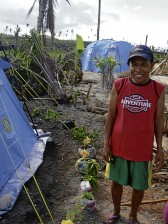Typhoon survivors getting used to life in a tent

MARIA Rodriguez and the plastic flowers around her tent in Barangay Ban-ao in Baganga, Davao Oriental Nico Alconaba/Inquirer Mindanao
BAGANGA, Davao Oriental—Maria Rodriguez, 65, walks around what was once her community in Ban-ao here. After finding what she was looking for, she picks these up, then walks to where she lives—a tent.
Around her dome-like house are plants on recycled tin cans and canisters. There, she places her recovered items—plastic flowers.
“I can’t wait for the plants to have flowers,” she told the Inquirer.
Rodriguez is one of 500 people living in the tent community of the nongovernment organization (NGO) Balay Mindanaw here. Her house in the shoreline, just a few meters across the tent community, was washed away by the sea surge when Typhoon “Pablo” hit this town and several other municipalities on Dec. 4.
Seventeen residents of Ban-ao were killed during the typhoon.
Article continues after this advertisement“My family and at least 50 neighbors were saved when we took shelter in the concrete house of my daughter,” she said. All that’s left of her daughter’s house were the walls.
Article continues after this advertisementNow Rodriguez, her husband and four other relatives stay in a tent provided by Rotary’s Disaster Aid International.
Among her new neighbors are Leila Abrahan, her husband Antero and their three children, who live in one of the tents.
When the Inquirer visited their tent, Leila was scolding her 2-year-old daughter who entered their new home with her slippers on. “I told you to always leave your slippers when entering the tent,” she told the child.
“She (her daughter) has to treat it (the tent) like a home,” she told the Inquirer.
There is sense of normalcy in this tent community: Residents doing what they used to do before Pablo, except cooking near the tents.
“We also cannot use gas lamps or candles,” Leila said.
“We have solar,” she added, pointing to the solar lantern and panel provided for her tent.
“We’re so grateful that Balay Mindanaw, Rotary International, the Red Cross and a lot of NGOs are helping us,” she said.
Like Rodriguez, most occupants also have plants, including vegetables like alogbati and kangkong, around their tents.
On Saturday, Balay Mindanaw distributed GI sheets and nails to the residents, in the hope that they would start rebuilding their houses, this time, away from danger zones.
Balay Mindanaw said it was still looking for ways to rent chainsaws to be used in processing fallen coconut trees into lumber.
The group also said it would need at least 3 hectares of land to create a new community for those affected by the typhoon.
Rodriguez said she was excited with the idea of building a new house.
“I will have a bigger garden there, with real flowers,” she said.